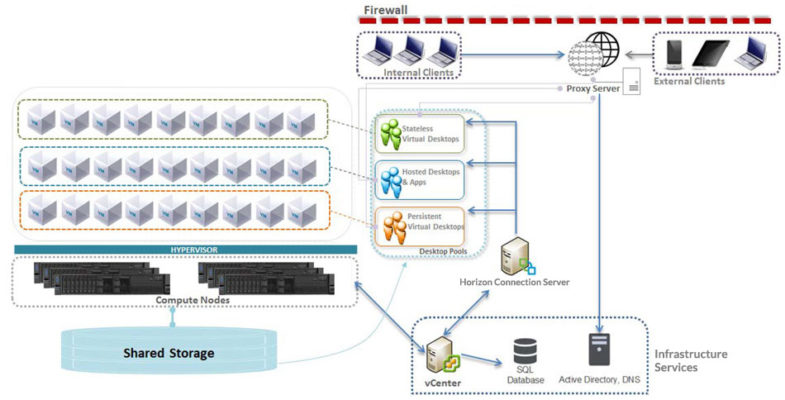Scale Up Remote Work With Smarter VDI

As companies look to a post-pandemic future, many are opting to retain remote-work arrangements. A survey by Gartner found that 82 percent of company leaders plan for remote work at least part of the week, and nearly half will allow employees to work from home full-time.
Since a distributed workforce is here to stay, the onus is on IT departments to create an architecture that supports it. Among other changes, the stopgap systems put in place during the crisis will need to be replaced by more sustainable solutions—and that often entails a move to cost-effective, scalable, and secure virtual desktop infrastructure (VDI).
Just one problem: Deploying and managing a VDI solution can be complex and costly. “A robust VDI solution requires infrastructure plus the necessary software stack to deliver a strong user experience,” says Srihari Angaluri, technical director for software and solutions for Lenovo, a leading provider of data center infrastructure solutions. If you were to do this piecemeal, it would be very arduous and error-prone.”
A Simpler Approach to VDI
To address these challenges, Lenovo combined forces with VMware and Intel to create an end-to-end solution, the Lenovo VMware Horizon VDI (Figure 1). “We simplify the process by doing all of the necessary groundwork to validate the solution,” explains Angaluri. “We consolidate everything onto the centralized infrastructure and deliver it as a service.”

Integrated with VMware’s Software-Defined Data Center—which includes vSphere, vSAN, and NSX—VMware Horizon enables IT departments to dynamically allocate resources, simplifying management while lowering costs. Tested and optimized for a wide variety of use cases, the solution also has robust security and disaster recovery features.
To deliver a consistent experience, VMware Horizon VDI leverages Intel® Optane persistent memory. “We’re able to break the barriers of traditional memory limitations that exist per processor,” says Todd Myrick, global product marketing manager for Lenovo. “We plug Intel Optane persistent memory into a regular DRAM slot, and in doing so we greatly increase the memory footprint. Anytime you reduce your server footprint, you drive down a lower network infrastructure cost and reduce licensing, power, cooling, and maintenance costs in the data center.”
“It’s much easier to operate a VDI environment with hyperconverged architecture,” says Lenovo’s Srihari Angaluri
Creating a VDI Solution For the Long Term
For a long-term solution, scalability is a key consideration. VMware Horizon is certified for use with the Lenovo ThinkAgile VX Series server, which offers a hyperconverged architecture that is superior to traditional three-tier architecture.
In a three-tier data center, the compute, network, and storage servers are three individual entities managed by three different groups. Hyperconverged infrastructure eliminates that complexity by combining the computer and storage servers into a single entity.
“The system, which is typically a two-socket server, becomes a building block,” says Angaluri. “You can combine multiple quantities into a cluster for linear scalability to increase capacity. And there is no need to add external storage.”
Hyperconverged architecture is especially attractive for VDI workloads, where you are hosting or consolidating user desktops. “If you support 150 users on one node and your company grows three times in the course of a year, you just add two more nodes,” says Jeff Huxtable, solutions marketing manager for Lenovo. “Likewise, you can spin down the nodes quickly. It’s much easier to operate a VDI environment with hyperconverged architecture.”
A Solution For Every Worker
A tech company that develops high-end software recently deployed VMware Horizon—a verified Intel® Select Solution—to its workforce due to the robust capabilities and cost savings the system can deliver.
“Their compute requirements are pretty high because they’re doing interactive modeling in 3D, running heavy-use stress tests,” says Angaluri. “Since they started working remotely, their software developers needed access to data that was located in remote data centers. They also wanted to reduce latency and have the ability to push out updates to remote workstations.”
The company also needed strong storage servers. A typical office work VDI use case would require between 20 and 50 IOPS from the storage measure. “With this particular customer, these desktops were driving upwards of 5,000 to 8,000 IOPS per desktop,” says Angaluri. “That’s pretty I/O intensive, so we had to design a VDI solution that would meet all those demands.”
For these “power” workers, Lenovo created a higher-end configuration with a two-socket ThinkAgile VX vSAN system as the hyperconverged infrastructure, plus VMware Horizon as the software layer. Lenovo also created a virtual desktop template for this special category of users to easily spin up/down virtual desktops on demand and added graphics acceleration adapters to the system for increased compute power.
“With our configuration, we can support more users in the future as necessary without having to reprovision the hardware,” says Angaluri. “We can support each type of worker with the right kind of system configuration.”
“Customers are asking us, ‘How can you help me improve my return on investment? How can you help me realize more VDIs per server? And how can you help me maximize the resources that are required to implement the solution?’” says Myrick. “VMware Horizon VDI systems configurator eliminates the guesswork. Our customers experience a smooth deployment and deliver a workload optimized configuration to their users—now and in the future.”